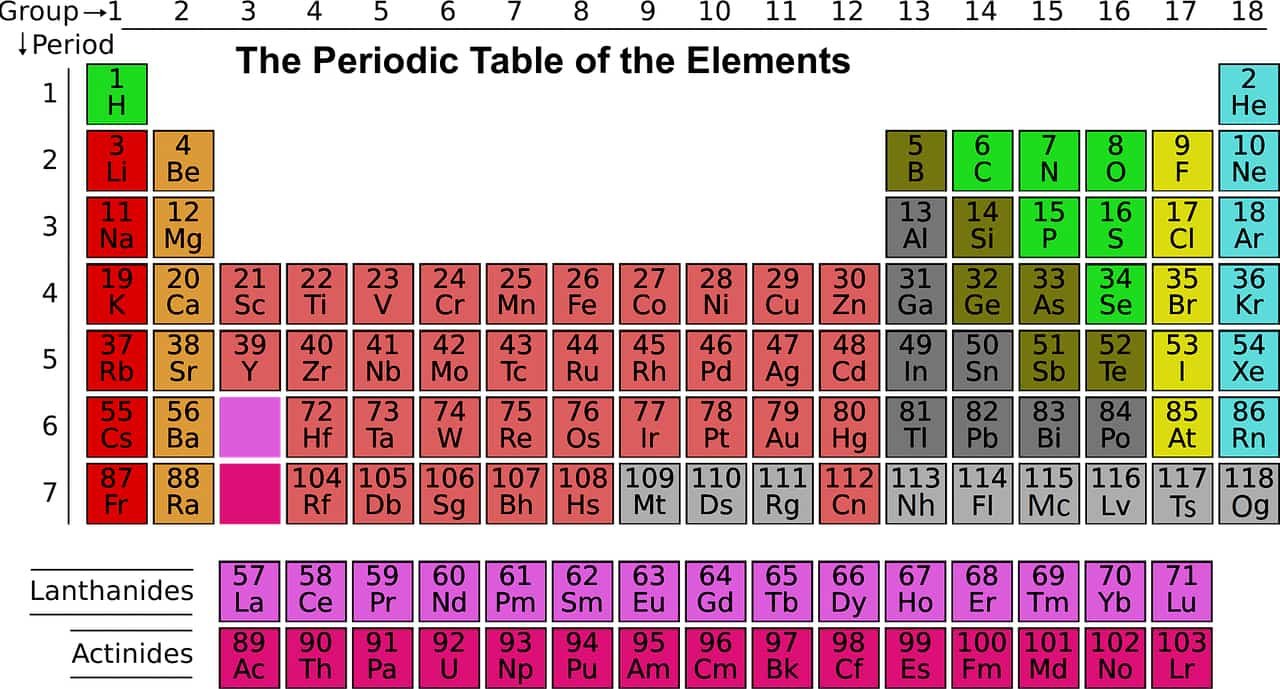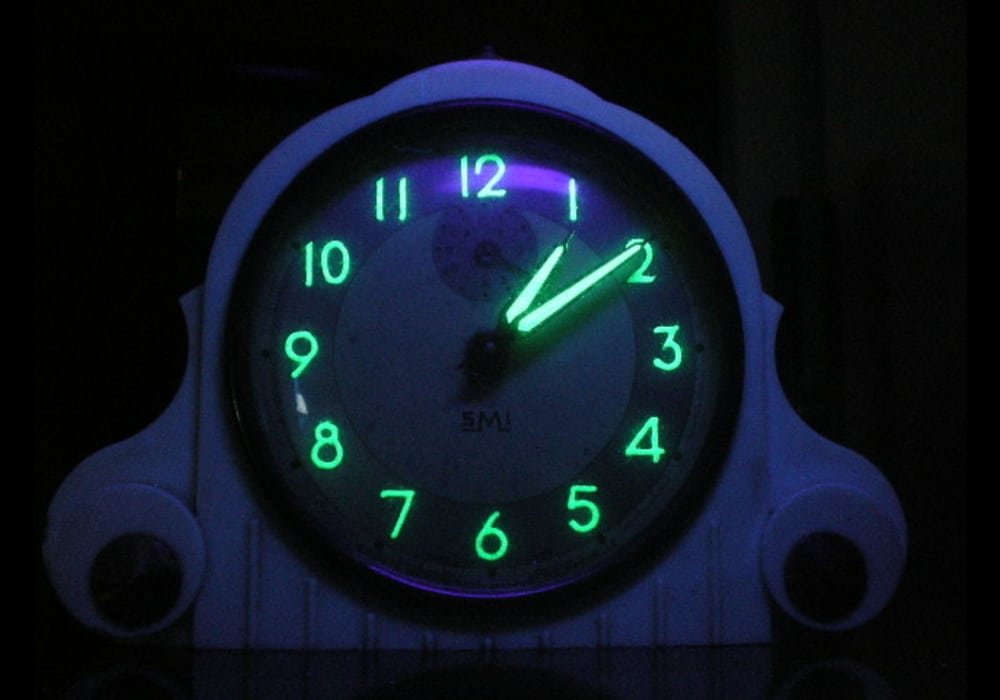Radium is the chemical element with atomic number 88, symbol Ra
Radium is perfectly white in appearance but darkens when exposed to the open air. Radium is an alkaline earth metal found in very small amounts in uranium ores. It is extremely radioactive, with the half-life of its most stable isotope (226Ra) being 1,600 years. It provides radon as a decay product.
Marie Curie and her husband Pierre discovered it in 1898 by extracting pitchblende, a uranium ore. The word radium is coined from the Latin radius (“radius”), along with the word radioactivity.
Luminescence source
Radium was used until the 1950s for its radioluminescent properties in paints for watchmaking, aviation and emergency signaling devices. This type of paint was obtained by incorporating radium (226Ra or more rarely 228Ra) in the form of sulfate, chloride or bromide in a zinc sulfide phosphorus38. The first American use identified was that of George F. Kunz, who had painted the hands of his watch with radium to see them in the dark, and filed a patent on this process in September 1903.
Ionization source
As early as 1914, the Hungarian physicist Béla Szilárd proposed to strengthen the natural ionization around lightning protection installations with radioactive sources placed near the tip of lightning rods. The idea leads to the commercialization of radioactive lightning rods, more simply nicknamed parads. These “Parads” having an activity of a few tens of MBq for alpha emitters, and being able to reach 1 GBq for others.
Uses of Radium
Radium is used in the production of luminous paints, as well as a source of neutrons. In medicine, radium is used in the treatment of cancer and other diseases. Radium loses about 1% of its activity in 25 years, because it is transformed into lighter elements. Lead is the end result of radium disintegration. Radium should be stored in a well-ventilated area to avoid radon formation.
doctors will use needles or radium applicators (bandages, poultices) to treat tumors and other skin conditions. The results on dermatological diseases as well as on skin cancer are very promising. This is why radiotherapy was subsequently tested on many incurable diseases of the time (cancer, tuberculosis, etc.).
Radium was also used during World War I to take x-rays in order to precisely locate bullets inside the wounded and thus facilitate surgical operations. Marie Curie participated in the design of mobile surgical units by creating eighteen radiology cars, nicknamed the “Petites Curies”, which were sent to the front.
From the beginning of the 20th century, radium was used to make radioluminescent paints. Indeed, the radium salts associated with zinc sulphide in a varnish constitute a paint which emits a low intensity continuous light. As a result, the watch industry will use these paints to make fluorescent alarm clocks and clocks. The radiofluorescent properties of radium have also been used for nighttime beaconing.
Lead is the end result of radium disintegration. Radium should be stored in a well-ventilated area to avoid radon formation.
The type of radium used to treat patients with metastatic prostate cancer which only spreads to the bone is Radium Ra 223.
A mixture of radium and beryllium emits neutrons and is used as a neutron source. Radium is used to produce radon, a gas used to treat several types of cancer. One gram of radium-226 will produce 0.000l milliliters of radon a day. Radium-226 is widely used in the manufacture of medical equipment such as calibrators, lightening rods, lightening rods, etc. In combination with plutonium, it is a component of the neutron generator.
Dangers and Risks with Radium
Radium is very radioactive and the product of its decay, radon gas is also radioactive. Because radium is chemically similar to calcium, it has the potential to cause major damage by replacing it in bone. Radium is more than a million times more reactive than the mass of Uranium equivalent. Radium handling has been blamed for Marie Curie’s premature death.
Health effects
The effects of ionizing radiation have been clearly established for very high exposure levels and in the case of ingestion of radioactive elements. This is because exposure to high levels involves a large number of DNA mutations. They end up not being repaired by DNA quality control organs and these mutations end up causing deterioration in the health of the cells concerned. The presence of such cells can thus cause an organ to no longer function normally and diseases to appear.
From all the studies carried out, it appears a statistical increase in the number of cancers, in particular leukemia and bone cancers of the sarcoma type – a malignant tumor of connective tissue – when the doses received are substantial.
An increase in the number of genetic diseases has also been observed following extensive irradiation. In addition, there is also an increase in the number of malformations and mental retardation in populations exposed in utero during pregnancy. Finally, doubts remain about the risk of multiplication of cardiovascular diseases.
In the particular case of radon, there is a multiplication of the risk of developing lung cancer following overexposure, this being even greater in individuals suffering from smoking. Regarding the effects of lower doses on health, it is generally considered that the impairment is proportional to the dose received (linear effect).
Different types of exposure
There are three types of exposure to radiation from radium and its descendants:
- external exposure.
- internal exposure by inhalation.
- internal exposure by ingestion.
These different types of exposure do not have the same biological consequences on individuals.
External exhibition
It is mainly due to γ and X radiation produced by radium and its descendants during their decay. The dose received here depends on the time the individual is exposed to the source as well as the distance from the radiation source. The essential point to consider here is that the exposure ceases as soon as the individual leaves the contaminated place, which is not the case with the other two types of exposure.
Internal exposure by inhalation
It can happen on two occasions. If we consider radon – produced by the decay of radium – exposure occurs because this element is gaseous: when the subject breathes, he stores radon in his lungs and entry into the body occurs at the level air-blood exchanges. Regarding the other elements of the radium family, only resuspension of radioactive particles in the air can lead to inhalation of them since they are not in the gaseous state.
Internal exposure by ingestion
Incorporation by ingestion of such elements can only occur in two cases:
if individuals grow food on contaminated land and consume it afterwards;
if individuals are in contact, especially by the hands, with contaminated soil and then put their exposed limbs in contact with their mouth.
In both cases, the contamination occurs throughout the digestive tract.
It is important to note that in the event of internal exposure, it is the ability of the individual’s body to excrete – through urine, stool and sweat – the radioactive elements that is involved: plus these will be eliminated quickly, the less serious will be the consequences at the biological level. From this perspective, it is interesting to note that the biological period – the time after which half of the substance which has entered the organism is eliminated externally – of radium is 900 days in the whole organism and 66 months especially in the bones. This important biological period in the case of bones is explained by the substitution that takes place in calcium by radium.
Radium in the periodic table
| Atomic number (Z) | 88 |
|---|---|
| Group | group 2 (alkaline earth metals) |
| Period | period 7 |
| Block | s-block |
| Electron configuration | [Rn] 7s2 |
| Electrons per shell | 2, 8, 18, 32, 18, 8, 2 |
Physical properties
| Physical properties | |
|---|---|
| Phase at STP | solid |
| Melting point | 973 K (700 °C, 1292 °F) (disputed) |
| Boiling point | 2010 K (1737 °C, 3159 °F) |
| Density (near r.t.) | 5.5 g/cm3 |
| Heat of fusion | 8.5 kJ/mol |
| Heat of vaporization | 113 kJ/mol |
Vapor pressure
| P (Pa) | 1 | 10 | 100 | 1 k | 10 k | 100 k |
|---|---|---|---|---|---|---|
| at T (K) | 819 | 906 | 1037 | 1209 | 1446 | 1799 |
Atomic properties
| Atomic properties | |
|---|---|
| Oxidation states | +2 (expected to have a strongly basic oxide) |
| Electronegativity | Pauling scale: 0.9 |
| Ionization energies |
|
| Covalent radius | 221±2 pm |
| Van der Waals radius | 283 pm |
Other properties
| Other properties | |
|---|---|
| Natural occurrence | from decay |
| Crystal structure | body-centered cubic (bcc) |
| Thermal conductivity | 18.6 W/(m·K) |
| Electrical resistivity | 1 µΩ·m (at 20 °C) |
| Magnetic ordering | nonmagnetic |
| CAS Number | 7440-14-4 |
History
| History | |
|---|---|
| Discovery | Pierre and Marie Curie (1898) |
| First isolation | Marie Curie (1910) |
Main isotopes of radium
| Main isotopes of radium | |||||||||||||||||||||||||||||||
|---|---|---|---|---|---|---|---|---|---|---|---|---|---|---|---|---|---|---|---|---|---|---|---|---|---|---|---|---|---|---|---|
| |||||||||||||||||||||||||||||||
Periodic Table of Elements | Complete List of Chemical Elements by Group, Name, Symbol, Color and Type

Sources: PinterPandai, Live Science, Royal Society of Chemistry
Photo credit: Wikimedia Commons
Photo explanations: The tip of the needle and the dots on the dial of this clock have been made fluorescent by the incorporation of radium salts.



